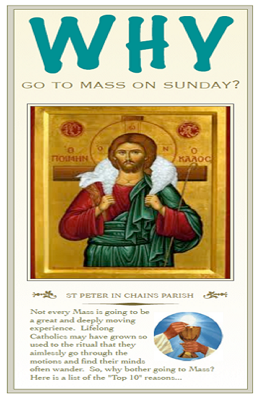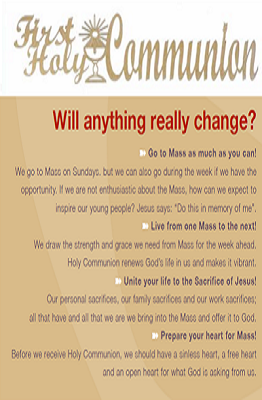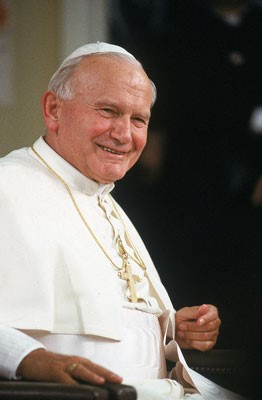Eucharist
The origins of the Eucharist are found in the Last Supper that Jesus shared with his Apostles. He instituted the Eucharist as the memorial of his death and Resurrection and commanded his apostles to celebrate it until his return; ‘thereby he constituted them priests of the New Testament.’ Holy Communion increases our union with Christ. Just as bodily food sustains our physical life, so Holy Communion nourishes our spiritual life. This Communion moves us away from sin, strengthening our moral resolve to avoid evil and turn ever more powerfully to God. Jesus changed the bread and wine into his Body and Blood, given now as an offering for the salvation of all people. By the words “Do this in memory of me,” Jesus commanded the Apostles and their successors to repeat his actions and words “until he comes again.” This practice has continued unbroken for two thousand years right up to the present day. The Mass is a sacrifice in the sense that when it takes place, Jesus Christ, through the bishop or priest celebrating the Mass, makes present sacramentally his saving, sacrificial death on the Cross by which he redeemed us from our sins. This Eucharistic sacrifice is the memorial of Christ’s redeeming death. The term memorial in this context is not simply a remembrance of past events; it is a making present in a sacramental manner the sacrifice of the Cross of Christ and his victory. In this divine sacrifice which is made present in the Mass, especially in the Eucharistic Prayer, the same Since the Middle Ages, the change of bread and wine into the Body and Blood of Christ has been called “transubstantiation”. This means that the substance of bread and wine is changed into the substance of the Body and Blood of Christ. The appearances of bread and wine remain (colour, shape, weight, chemical composition), but the underlying reality – that is the substance – is now the Body and Blood of Christ, with his soul and divinity. The Real Presence of Jesus Christ endures in the consecrated elements even after Mass has ended. Once Communion has been distributed, any remaining hosts are placed in the Tabernacle. If any of the Precious Blood remains, it is reverently consumed. The hosts are reserved to provide Communion to the sick or dying, and to allow the faithful tow worship Christ in the reserved Sacrament and to pray in his presence. As a sign of adoration, Catholics genuflect to the Real Presence of Jesus Christ in the tabernacle or genuflect or kneel when the Blessed Sacrament is exposed for prayer.
THE VEIL REMOVED
What is the Veil Removed?
The Veil Removed is a short film that reveals the coming together of heaven and earth at Mass, as seen by saints and mystics, revealed by scripture and in the catechism of the Catholic Church. It is a simple aid to the participation and understanding of the Eucharist by igniting amazement through the miraculous beauty of the Catholic Mass. The Catechism of the Catholic Church says:
1370 To the offering of Christ unites not only the members still here on earth, but also those already in the glory of heaven. In communion with and commemorating the Blessed Virgin Mary and all the saints, the Church offers the Eucharistic sacrifice. In the Eucharist the Church is as it were at the foot of the cross with Mary, united with the offering and intercession of Christ.
1419 Having passed from this world to the Father, Christ gives us in the Eucharist the pledge of glory with him. Participation in the Holy Sacrifice identifies us with his Heart, sustains our strength along the pilgrimage of this life, makes us long for eternal life, and unites us even now to the Church in heaven, the Blessed Virgin Mary, and all the saints.
1326 Finally, by the Eucharistic celebration we already unite ourselves with the heavenly liturgy and anticipate eternal life, when God will be all in all.
335 In her liturgy, the Church joins with the angels to adore the thrice-holy God. She invokes their assistance (in the funeral liturgy’s In Paradisum deducant te angeli. . .[“May the angels lead you into Paradise. . .”]). Moreover, in the “Cherubic Hymn” of the Byzantine Liturgy, she celebrates the memory of certain angels more particularly (St. Michael, St. Gabriel, St. Raphael, and the guardian angels).
Why go to Mass? Leaflet
Parents’ Information: First Holy Communion – The Greatest Gift
“Stay with us Lord” Letter from St Pope John Paul II
Mission Statement
The Church of Saint Peter in Chains is a Catholic Church in Ardrossan, Ayrshire, Scotland. Saint Peter in Chains belongs to the Roman Catholic Diocese of Galloway. It is a relatively young Church having been opened in 1938. Most Churches in the surrounding towns are well over a hundred years old. The Parish hopes to re-energise the local Church through authentic witness that can inspire people to rediscover the message of Catholicism.
We hope to play an active part in the New Evangelisation by striving to be “missionary disciples”. This website exists for two reasons. Firstly, it informs the community of Church services and other events and secondly, it records the history of the parish. These aims form our mission statement.


